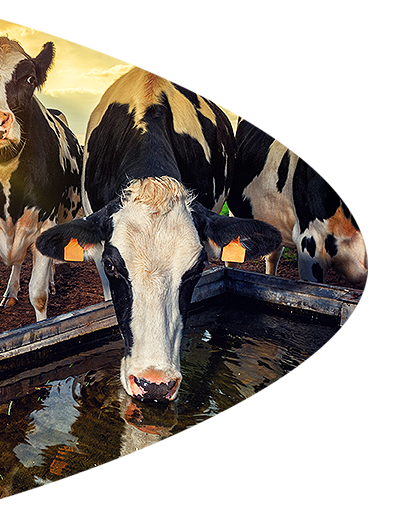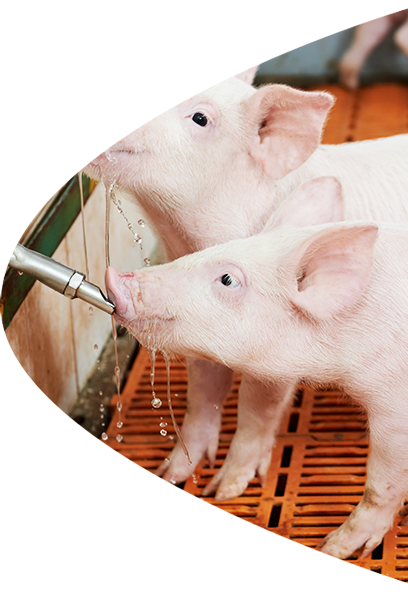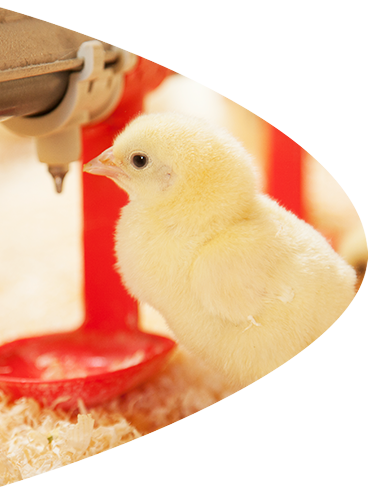Clean water is essential to healthy animals. Contaminated water not only leads to diseases, but it can have a significant impact on growth and productivity. Studies1) show that animals with good quality water, grow faster and healthier, reducing the need for antibiotic treatment.
On farms, several key pathogens can be transmitted in water sources that can lead to various diseases. It’s crucial for farms to maintain proper water management and sanitation practices to minimize the risk of pathogen contamination and subsequent disease outbreaks. Regular testing, good hygiene, and following appropriate biosecurity measures are essential to ensure the health and safety of both animals and humans.
Key Pathogens that can be transmitted through Water:
Kersia’s approach to offer healthy and clean water to your animals is achieved through a comprehensive water hygiene program containing 4 necessary steps:
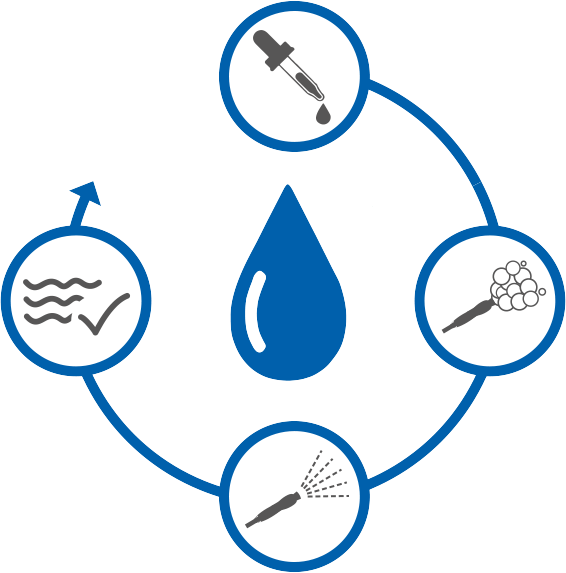
1. Análisis
Realice un análisis del agua para determinar la carga microbiana y los niveles de incrustaciones que conducen a la contaminación microbiana.
2. Limpieza
a) Selección de un producto de limpieza adecuado para el exterior de las tuberías y canales.
b) Selección de un agente de limpieza y descalcificador adecuado para el interior de las tuberías y tanques.
3. Desinfección de choque
Desinfección de choque durante la fase de limpieza y desinfección de los cobertizos o de forma regular.
4. Tratamiento continuo del agua
Choose a suitable water disinfection treatment for avoiding the reestablishment of the exopolysaccarides matrix (EPS) which is bearing the biofilm and to ensure
1. Analysis
Conduct a water analysis to determine the microbial load and scale levels leading to microbial contamination.
4. Continous water treatment
Choose a suitable water disinfection treatment for avoiding the reestablishment of the exopolysaccarides matrix (EPS) which is bearing the biofilm and to ensure continuous supply of clean water.

2. Cleaning
a) Selection of a suitable cleaning agent for the outside of the pipes and troughs.
b) Selection of a suitable cleaning agent and descaler for the inside of the pipes and tanks.
3. Shock Disinfection
Shock disinfection during cleaning and disinfection phase of the sheds or on a regular base.

Continuous water treatment by Aquatabs® and Aquatabs InLine
It is essential that no part of the water system is overlooked in the cleaning and disinfection procedure. On-going water treatment with products such as Aquatabs® and Aquatabs InLine, a world leader in water disinfection, is essential to ensure microbial levels remain low and for avoiding the reestablishment of the exopolysaccarides (EPS) matrix which is critical to the function and support of biofilm.
ADVANTAGES
-
Simple to use
-
Dissolves rapidly and completely
-
Maintains healthy water
-
Assists in the control of biofilm built up – avoids the reestablishment of the
exopolysaccarides (EPS) matrix which is critical to the function and support of biofilm -
Assists in the control of calcium deposits at nipple drinkers and pipes
-
Generates optimum pH-level
-
Optimises performance
-
Contains no heavy metals

ADVANTAGES
-
Suitable for all water systems; mains, wells and boreholes
-
Easy to install, no power required
-
Low maintenance and no moving parts
-
Assists in the control of biofilm built up – avoids the reestablishment of the exopo-lysaccarides (EPS) matrix which is critical to the function and support of biofilm
-
Assists in the control of calcium deposits at nipple drinkers and pipes
-
Generates optimum pH-level
-
Maintains healthy water
-
Cost effective and sustainable water solution
-
Dosing of integrated water units and systems at POC (point of collection)
-
Continuous / automatic dosing on the flow of water at point of entry into a tank or in-line for gravity /open and/or pressurized water systems
Key pathogens that can be transmitted through water on DAIRY FARMS
On dairy farms, various pathogens can be found in water sources, which can lead to several diseases in both animals and humans. Here are some of the key pathogens and the associated diseases:
- Escherichia coli (E. coli): Certain strains of E. coli, including pathogenic E. coli O157:H7, can contaminate water on dairy farms. In cattle, E. coli infection can cause diarrhea, reduced milk production, and in severe cases, kidney damage or death. In humans, ingestion of contaminated dairy products or water can lead to gastrointestinal illness with symptoms like diarrhea, abdominal cramps, and, in some cases, kidney damage.
- Cryptosporidium: Cryptosporidium is a protozoan parasite that can contaminate water sources on dairy farms. In cattle, Cryptosporidium infection can cause diarrhea, dehydration, and weight loss. In humans, ingestion of contaminated dairy products or water can lead to cryptosporidiosis, which presents as watery diarrhea, stomach cramps, and nausea.
- Salmonella: Salmonella bacteria can be found in water on dairy farms, primarily through fecal contamination. In cattle, Salmonella infection can cause diarrhea, fever, dehydration, and abortion in pregnant cows. In humans, consumption of contaminated dairy products or water can lead to salmonellosis, characterized by symptoms such as diarrhea, abdominal pain, fever, and vomiting.
- Listeria monocytogenes: Listeria monocytogenes is a bacterium that can contaminate water on dairy farms. In cattle, Listeria infection may cause mild to severe symptoms like fever, diarrhea, reduced milk production, and reproductive issues. In humans, consumption of contaminated dairy products can result in listeriosis, which can lead to flu-like symptoms, meningitis, septicemia, and, in severe cases, death.
- Campylobacter: Campylobacter species, especially Campylobacter jejuni, can be present in water sources on dairy farms. In cattle, Campylobacter infection can cause diarrhea, reduced milk yield, and weight loss. In humans, ingestion of contaminated dairy products or water can lead to campylobacteriosis, characterized by symptoms like diarrhea (sometimes bloody), abdominal pain, and fever.
It is crucial for dairy farms to prioritize water quality and implement proper sanitation measures to reduce the risk of pathogen contamination. Regular monitoring, good hygiene practices, and adherence to recommended biosecurity protocols can help minimize the spread of pathogens and protect both animal and human health on dairy farms.
Key pathogens that can be transmitted through water on PIG FARMS
On pig farms, various pathogens can be found in water sources, which can lead to several diseases in pigs and, in some cases, pose a risk to human health. Here are some of the key pathogens and the associated diseases:
- Porcine Epidemic Diarrhea Virus (PEDV): PEDV is a viral pathogen that can contaminate water on pig farms. It causes porcine epidemic diarrhea (PED), characterized by severe diarrhea, vomiting, dehydration, and high mortality rates in piglets.
- Porcine Reproductive and Respiratory Syndrome Virus (PRRSV): PRRSV is a viral pathogen commonly found on pig farms. It can be present in water contaminated with pig urine or saliva. PRRSV causes porcine reproductive and respiratory syndrome (PRRS), which results in reproductive issues, respiratory problems, reduced growth, and increased mortality rates in pigs.
- Brachyspira hyodysenteriae: This bacterium is responsible for causing swine dysentery, a highly contagious and economically significant disease in pigs. It can contaminate water on pig farms and lead to symptoms such as bloody diarrhea, weight loss, and decreased feed intake.
- Salmonella: Various Salmonella species can be found in water on pig farms. Contamination can occur through pig feces. In pigs, Salmonella infection can cause enteric disease with symptoms like diarrhea, fever, and dehydration. Some Salmonella strains can also pose a risk to human health if contaminated pork products are consumed.
- Escherichia coli (E. coli): E. coli is a diverse bacterium that can be present in water on pig farms. Some strains, such as enterotoxigenic E. coli (ETEC) and enteropathogenic E. coli (EPEC), can cause diarrhea and colibacillosis in piglets. Certain pathogenic E. coli strains, like E. coli O157:H7, can also pose a risk to humans if contaminated pork products are consumed.
- Streptococcus suis: Streptococcus suis is a bacterial pathogen commonly associated with pig farms. It can contaminate water and lead to infections in pigs, causing diseases such as meningitis, pneumonia, arthritis, and septicemia.
- Leptospira spp.: Leptospira bacteria can contaminate water sources on pig farms. In pigs, infection with Leptospira can lead to leptospirosis, characterized by fever, reproductive problems, kidney damage, and potentially death.
- African Swine Fever: besides primary routes of transmission, ASF is proven that can be transmitted through feed and liquids. Recent studies indicate that transmission of ASFV through drinking water is much more efficient than through feed (Niederwerder et al. 2019). In another study was proven that ASF virus can survive in water at room temperature more than 50 days. (Sindryakova et al. 2016)
Proper water management, biosecurity practices, and sanitation protocols are essential on pig farms to minimize the risk of pathogen contamination. Regular monitoring, vaccination programs, and adherence to good hygiene practices can help control the spread of pathogens and reduce the impact of diseases on pig health and farm productivity.
Key pathogens that can be transmitted through water on POULTRY FARMS
On poultry farms, several key pathogens can be found in water sources that can lead to various diseases. Here are some of the common pathogens and the diseases they can cause:
- Salmonella: Salmonella species are a significant concern in poultry farming. Contaminated water can harbor Salmonella bacteria, leading to salmonellosis in both poultry and humans. In humans symptoms include diarrhea, abdominal pain, fever, and vomiting.
- Campylobacter: Campylobacter jejuni is another common bacterial pathogen associated with poultry. It can be present in water contaminated with feces, causing campylobacteriosis. In humans, symptoms include diarrhea (sometimes bloody), abdominal pain, and fever.
- Escherichia coli (E. coli): Certain strains of E. coli, such as pathogenic E. coli O157:H7, can be found in poultry farm water. Contamination can occur through fecal matter. In humans, infection can lead to gastrointestinal illness with symptoms like diarrhea (often bloody), abdominal cramps, and sometimes kidney damage.
- Avian Influenza: Avian influenza viruses (such as H5N1 or H7N9) can survive in water and infect poultry. These viruses pose a risk to both animal and human health. In poultry, avian influenza can cause severe respiratory illness and high mortality rates.
- Cryptosporidium: Cryptosporidium is a parasitic protozoan that can contaminate water on poultry farms. It causes cryptosporidiosis, an intestinal disease in both animals and humans. Symptoms include watery diarrhea, stomach cramps, and nausea.
- Mycoplasma gallisepticum: This bacterium causes chronic respiratory disease in poultry, leading to reduced egg production, respiratory distress, and conjunctivitis. While it primarily affects poultry, there is a low risk of human infection.
- Pasteurella multocida: This bacterium is commonly associated with poultry respiratory diseases such as fowl cholera. It can cause septicemia, respiratory distress, swollen joints, and death in infected birds.
It’s crucial for poultry farms to maintain proper water management and sanitation practices to minimize the risk of pathogen contamination and subsequent disease outbreaks. Regular testing, good hygiene, and following appropriate biosecurity measures are essential to ensure the health and safety of both poultry and humans.




